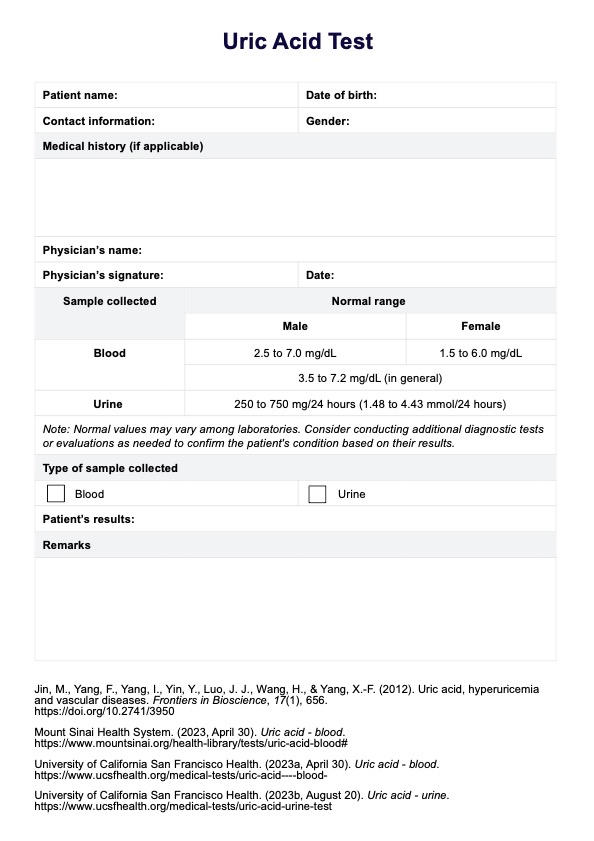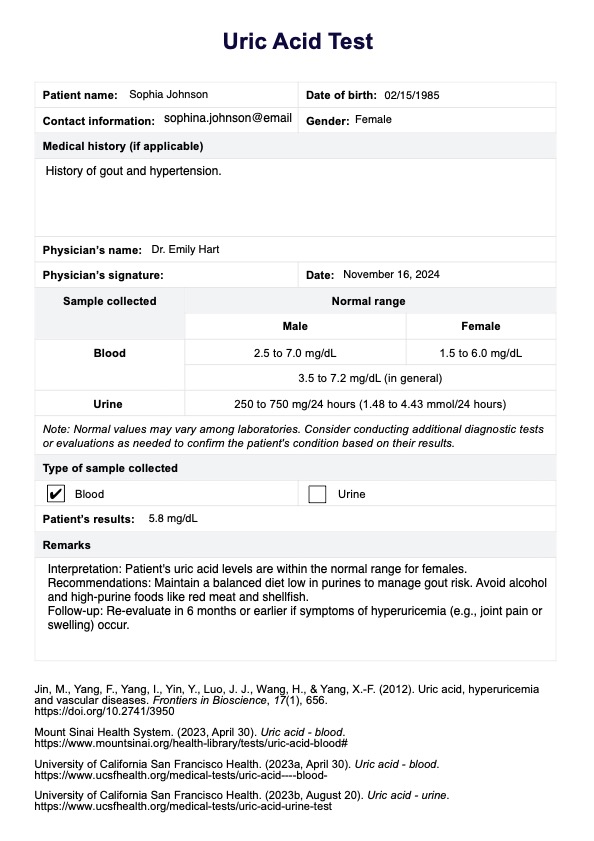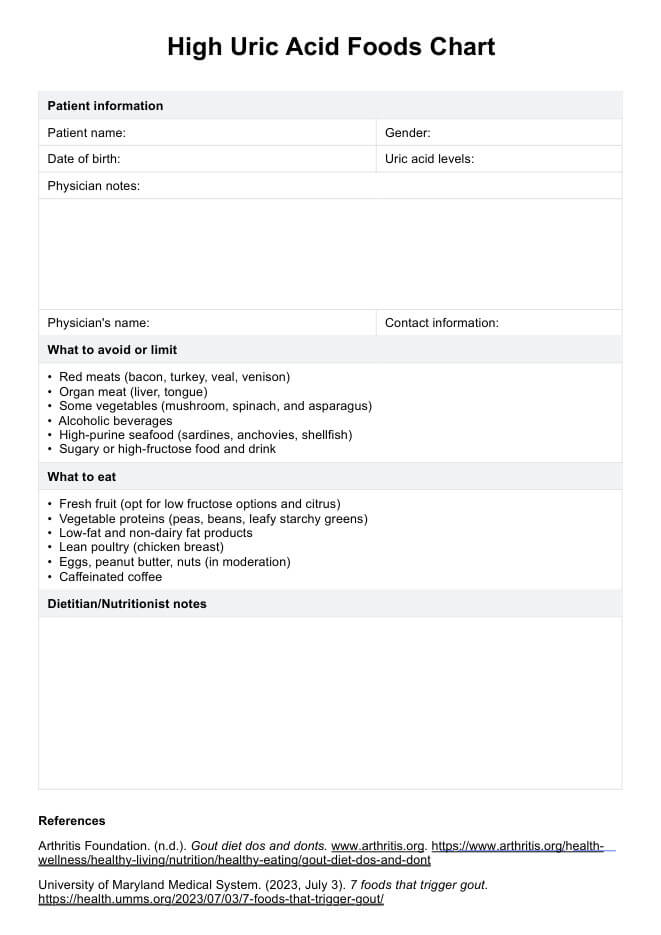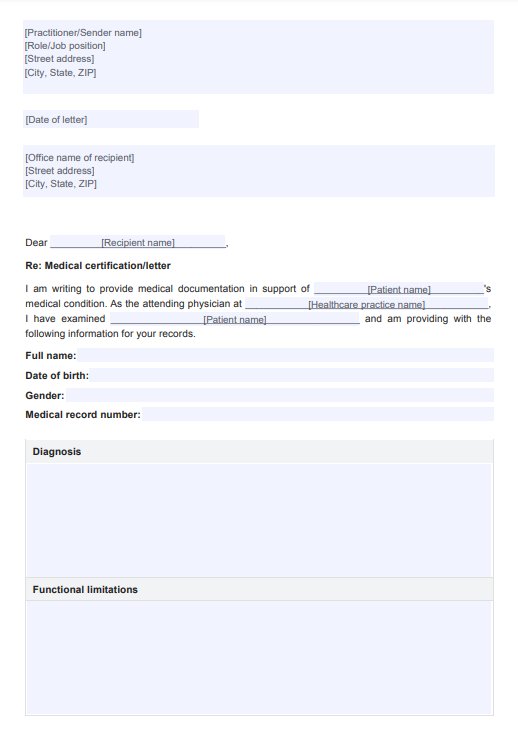Uric Acid
Use or Uric Acid Test template to document and manage patients' uric acid levels efficiently for accurate and effective care.


What is a Uric Acid Test?
A Uric Acid Test or uric acid testing is a medical examination that measures the concentration of uric acid in the blood or urine, providing essential information on how the body processes this compound. According to Barr (1990), uric acid is produced during the breakdown of purines, substances found in certain foods and naturally occurring in the body.
There are two main types of uric acid tests: the blood test (or serum Uric Acid Test) and the urine test. The uric acid blood test measures a uric acid level in the bloodstream and is often used to diagnose and monitor conditions like gout and kidney disease or to assess kidney function after trauma or certain cancer treatments that increase cell breakdown.
The uric acid urine test measures the amount of uric acid excreted over a 24-hour period, helping to determine whether an elevated uric acid level is due to increased production or decreased elimination by the kidneys.
Uric Acid Test Template
Uric Acid Test Example
How does it work?
Medical professionals can use Carepatron’s Uric Acid Test template to streamline the process of conducting and recording tests efficiently. Below are the steps for effectively using the template.
Step 1: Access the test template
You can access the template directly through this guide or by navigating the Carepatron platform. The template is designed for ease of use, helping practitioners quickly record and manage patient information related to uric acid blood tests and urine test procedures. We also have a Uric Acid Test report sample for your reference.
Step 2: Explain the process to the patient
Explain the purpose and process of the Uric Acid Test to the patient. Determine whether a urine or blood sample will be collected. Then, clearly discuss how the test will measure uric acid levels in either blood or urine and why this information is essential for diagnosing potential conditions like gout, kidney stones, or kidney disease.
Step 3: Record the results
Record the uric acid results within the template and compare them against normal reference values. We've included a section for you to note observations and interpretation of the test results.
Step 4: Provide patient education and next steps
Explain the implications of their uric acid levels and offer guidance on managing or reducing too much uric acid if necessary. Discuss lifestyle changes, medications, or follow-up plans to support ongoing health.
When would you use this test?
Most uric acid tests help diagnose and manage various health conditions related to the breakdown and elimination of substances called purines. Below are common instances when this test is used.
Diagnosing gout
Medical professionals use uric acid blood tests when patients exhibit symptoms like joint pain or swelling, common indicators of gout. High levels of uric acid can lead to uric acid crystals forming in the joints, causing pain and inflammation.
Monitoring chronic kidney disorders
In terms of kidney function, monitoring and adjusting treatment is crucial to ensure uric acid dissolves properly and does not contribute to stone formation or other complications.
Evaluating the risk of kidney stones
When patients have a history of or are at risk for kidney stones, a uric acid urine test helps identify whether high levels of uric acid contribute to stone formation. This test provides insights into whether the body breaks down purines excessively or the kidneys fail to excrete uric acid effectively, supporting prevention and treatment strategies.
Results and interpretation
Both blood and urine tests provide valuable insights how much uric acid levels are in your body and help healthcare professionals make informed decisions about patient care. Here's what the results may indicate:
Normal uric acid levels
Generally, it ranges from 3.5 to 7.2 mg/dL (Mount Sinai Health System, 2023; University of California San Francisco Health, 2023a). According to Jin (2012), normal uric acid levels in a blood test are defined as 1.5 to 6.0 mg/dL for women and 2.5 to 7.0 mg/dL for men. Uric acid typically exists as urate, and when blood concentrations increase beyond 6.8 mg/dL, there is a risk of uric acid crystal formation, which can lead to conditions like gout. The average concentration of uric acid in healthy individuals approaches this solubility limit, making monitoring essential for preventing complications.
On the other hand, according to the University of California San Francisco Health (2023b), normal values for urine tests generally range from 250 to 750 mg/24 hours. However, specific ranges may vary among laboratories, and it is essential to consult with a healthcare provider regarding individual results.
Elevated Uric Acid Test results
Elevated uric acid levels suggest hyperuricemia, according to George & Minter (2019), defined as blood levels exceeding 7.0 mg/dL for men or 6.0 mg/dL for women. High levels of uric acid in the urine can indicate conditions such as gout, where the accumulation of uric acid crystals in the joints causes inflammation and pain. Additionally, elevated levels may suggest an increased breakdown of purines.
Low Uric Acid Test results
Low uric acid levels can signal underlying health issues. According to Li et. al (2017), low uric acid levels can lead to acute central nervous system viral infections. Low uric acid levels may also indicate metabolic hereditary diseases or HIV infection. A low uric acid level in urine can also result from chronic kidney disease, which limits the kidneys' ability to eliminate uric acid, potentially causing gout or kidney damage.
Consider conducting additional diagnostic tests or evaluations as needed to confirm the patient's condition based on their results.
References
Barr, W. G. (1990). Uric acid. In H. K. Walker, W. D. Hall, & J. W. Hurst (Eds.), Clinical methods: The history, physical, and laboratory examinations (3rd ed., p. Chapter 165). Butterworths. https://www.ncbi.nlm.nih.gov/books/NBK201/
George, C., & Minter, D. A. (2019, June 4). Hyperuricemia. National Library of Medicine; StatPearls Publishing. https://www.ncbi.nlm.nih.gov/books/NBK459218/
Jin, M., Yang, F., Yang, I., Yin, Y., Luo, J. J., Wang, H., & Yang, X.-F. (2012). Uric acid, hyperuricemia and vascular diseases. Frontiers in Bioscience, 17(1), 656. https://doi.org/10.2741/3950
Li, X., Tong, Q., Xie, D., Chen, Z., Pan, S., Zhang, X., & Dong, W. (2017). Low serum uric acid levels in patients with acute central nervous system viral infections. NeuroReport, 28(18), 1250–1254. https://doi.org/10.1097/wnr.0000000000000908
Mount Sinai Health System. (2023, April 30). Uric acid - blood. https://www.mountsinai.org/health-library/tests/uric-acid-blood#
University of California San Francisco Health. (2023a, April 30). Uric acid - blood. https://www.ucsfhealth.org/medical-tests/uric-acid----blood-
University of California San Francisco Health. (2023b, August 20). Uric acid - urine. https://www.ucsfhealth.org/medical-tests/uric-acid-urine-test
Commonly asked questions
If uric acid levels are high, they can lead to conditions such as gout, characterized by painful joint inflammation caused by uric acid crystal formation. Additionally, consistently elevated levels may increase the risk of kidney stones and vascular diseases.
A Uric Acid Test indicates how well the body produces and eliminates uric acid, helping diagnose conditions like gout, kidney disease, and metabolic disorders. It provides insight into the patient's overall health and can guide treatment decisions.
The first symptoms of high uric acid levels typically include sudden and severe joint pain, often starting in the big toe, accompanied by swelling and redness. Patients may also experience warmth in the affected area, which indicates inflammation from uric acid crystal deposits.















































































































